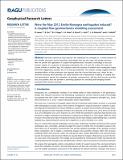| dc.contributor.author | Shaw, J. H. | |
| dc.contributor.author | Plesch, A. | |
| dc.contributor.author | Astiz, L. | |
| dc.contributor.author | Dieterich, J. H. | |
| dc.contributor.author | Frohlich, C. | |
| dc.contributor.author | Juanes, Ruben | |
| dc.contributor.author | Jha, Birendra | |
| dc.contributor.author | Hager, Bradford H | |
| dc.date.accessioned | 2017-01-19T21:24:23Z | |
| dc.date.available | 2017-01-19T21:24:23Z | |
| dc.date.issued | 2016-07 | |
| dc.date.submitted | 2016-04 | |
| dc.identifier.issn | 00948276 | |
| dc.identifier.uri | http://hdl.handle.net/1721.1/106543 | |
| dc.description.abstract | Seismicity induced by fluid injection and withdrawal has emerged as a central element of the scientific discussion around subsurface technologies that tap into water and energy resources. Here we present the application of coupled flow-geomechanics simulation technology to the post mortem analysis of a sequence of damaging earthquakes (Mw = 6.0 and 5.8) in May 2012 near the Cavone oil field, in northern Italy. This sequence raised the question of whether these earthquakes might have been triggered by activities due to oil and gas production. Our analysis strongly suggests that the combined effects of fluid production and injection from the Cavone field were not a driver for the observed seismicity. More generally, our study illustrates that computational modeling of coupled flow and geomechanics permits the integration of geologic, seismotectonic, well log, fluid pressure and flow rate, and geodetic data and provides a promising approach for assessing and managing hazards associated with induced seismicity. | en_US |
| dc.language.iso | en_US | |
| dc.publisher | American Geophysical Union (AGU)/Wiley | en_US |
| dc.relation.isversionof | http://dx.doi.org/10.1002/2016GL069284 | en_US |
| dc.rights | Article is made available in accordance with the publisher's policy and may be subject to US copyright law. Please refer to the publisher's site for terms of use. | en_US |
| dc.source | MIT Web Domain | en_US |
| dc.title | Were the May 2012 Emilia-Romagna earthquakes induced? A coupled flow-geomechanics modeling assessment | en_US |
| dc.type | Article | en_US |
| dc.identifier.citation | Juanes, R., B. Jha, B. H. Hager,et al. “Were the May 2012 Emilia-Romagna Earthquakes Induced? A Coupled Flow-Geomechanics Modeling Assessment.” Geophysical Research Letters, vol. 43, no. 13, 2016, pp. 6891-6897. © 2016 American Geophysical Union. | en_US |
| dc.contributor.department | Massachusetts Institute of Technology. Department of Civil and Environmental Engineering | en_US |
| dc.contributor.department | Massachusetts Institute of Technology. Department of Earth, Atmospheric, and Planetary Sciences | en_US |
| dc.contributor.mitauthor | Juanes, Ruben | |
| dc.contributor.mitauthor | Jha, Birendra | |
| dc.contributor.mitauthor | Hager, Bradford H | |
| dc.relation.journal | Geophysical Research Letters | en_US |
| dc.eprint.version | Final published version | en_US |
| dc.type.uri | http://purl.org/eprint/type/JournalArticle | en_US |
| eprint.status | http://purl.org/eprint/status/PeerReviewed | en_US |
| dspace.orderedauthors | Juanes, R.; Jha, B.; Hager, B. H.; Shaw, J. H.; Plesch, A.; Astiz, L.; Dieterich, J. H.; Frohlich, C. | en_US |
| dspace.embargo.terms | N | en_US |
| dc.identifier.orcid | https://orcid.org/0000-0002-7370-2332 | |
| dc.identifier.orcid | https://orcid.org/0000-0003-3855-1441 | |
| mit.license | PUBLISHER_POLICY | en_US |
